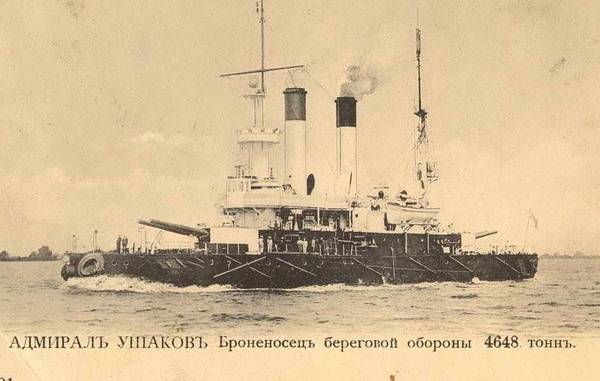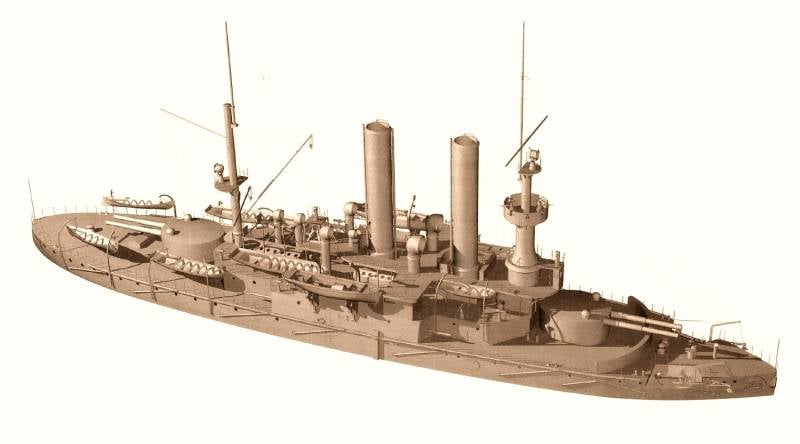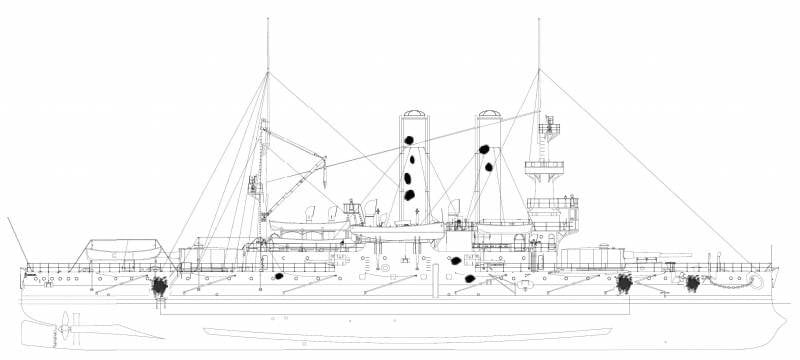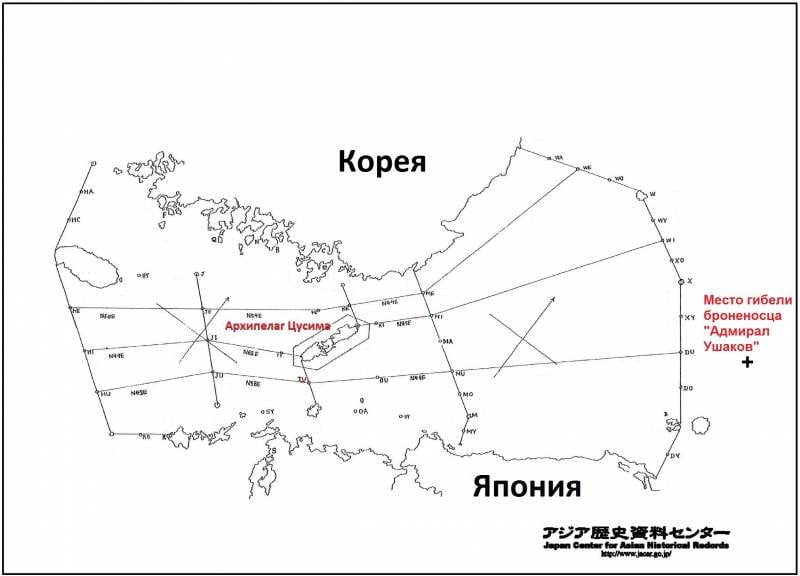Battleship "Admiral Ushakov" in battles
Emperor Nicholas II

After the commissioning of the next, in 1898, the battleship of the coastal defense "Admiral Ushakov" was annually included for three weeks in the Training and artillery unit of the Baltic fleet to improve the training of gunners. Intensive training firing led to the end of the campaign in 1904, during which 10 shells were fired from only 140 '' guns of the battleship, the total number of shots fired by the ship from main guns reached 472 (total training and combat), which seriously affected the wear of the gun barrels. The 120-mm rapid-fire guns were in an even worse position, each of which already had about 400 shots.
The Special Meeting held a few days before the capitulation of Port Arthur was decided, and three days later, on December 14 1904, the highest order followed to send the first echelon of the 3 Pacific squadron as part of the 1 Separate detachment of ships to the Far East Under the flag of Rear Admiral N. I. Nebogatov, whose departure from Libava was assigned to 15 in January 1905. The preparation of ships for sailing was carried out in the port of Emperor Alexander III, where, to speed up the work, to which, at the request of the manager of the Maritime Ministry m. Admiral F. K. Avelan, Emperor Nicholas II allowed to allocate 2 000 000,00 rubles. More than a thousand and a half workers of state-owned and private factories were assembled.
"Ushakov" was introduced into the dock, where the underwater part was cleaned and reddened, the sides, pipes and superstructures were covered with black paint. In the course of partial modernization from Mars, who lost part of the structure, they dismantled ten 37-mm single-barreled Hotchkiss cannons, placing instead two Maxim machine guns with shields; on the spardek, instead of the six Hotchkis 37-mm five-barrel guns, Hotchkis installed four Hotchkis 47-mm guns without shields. They removed jewelry from the bow and stern, dismantled the bow and stern torpedo tubes, and also removed the throwing torpedo tubes from the steam boats. Thanks to these and a number of other activities, the construction overload of the battleship in 468 tons was reduced by about one hundred tons.
In addition to the GUKiS, the Obukhov Plant manufactured six new 120-mm guns, two of which were replaced by the most worn out ones at Admiral Ushakov.
Four rangefinders were delivered to the battleship: two that were withdrawn from the artillery class of the Baltic Fleet training and artillery detachment (presumably one FA 2 from Barr and Stroud and one from Carl Zeiss) and two companies “Barr and Stroud” of the last modification FA 3 (start of production in 1903), as well as the Belgian handheld optical rangefinders manufactured by the Fabrique Nationale Herstal Liège factory (fact not mentioned in domestic sources). The 120 mm and 10 caliber guns were obtained by the Perepyolkin’s Russian optical sights (Lieutenant Ya. N. Perepyolkin). Also, Admiral Ushakov installed the Slaby-Arco wireless system of the Telefunken Society, developed by Dr. A. Slaby (Adolf KH Slaby) and his collaborator Count G. von Arco (Georg Graf von Arco). Based on the 80 shells on the barrel, for the "Admiral Ushakov" 320 10 "shells were released (including 92 armor piercing, high explosive 198, 30 segment), of which only 300 fit on the ship. 840 120-mm cartridges were also loaded (on 210 per barrel), of which 200 was with armor-piercing projectiles, 480 with high-explosive and 160 with segment.
Due to delays caused by workers' strikes, incited by agitators funded from abroad, as well as by difficult weather conditions, the Separate Detachment took place only on February 3 1905.
In the course of the artillery study that continued during the march, both barreled and caliber shooting were carried out. 28 March 1905 in the Gulf of Aden was the first training squad shooting, from each gun of the main caliber four shots of high-explosive shells were made at once. Two weeks later, the training was continued, and the battleship's 10 guns fired four more shells, and three days later, during the loading of coal, the ammunition spent on training firing was replenished from the transport ships accompanying the detachment. Thus, as of the beginning of the Tsushima battle, the guns of the main caliber "Admiral Ushakov" fired around 504 shots. Looking ahead, we note that, as follows from the testimony of the senior navigator officer, Lieutenant E. A. Maximov, 4, 14, in May, 1905, the battleship fired another 200 operating time, up to 10. From the 704-mm guns, according to the same information, about 120 shells were fired during the battle. Consequently, "Admiral Ushakov" joined the battle with two armored cruisers, having an average of 400 shots per gun of the main caliber. At the same time, according to the standards of the ITC, the survivability of the barrel 176 "gun" was 10 combat shots on the barrel (which looks unreasonably optimistic against the background, for example, the rate of one hundred combat shots for the American 10 "/ 40 MkIII guns, mounted on Tennessee-type armored cruisers), and 120-mm - 1 000. This could not but affect the wear of the barrels, which led to a loss of speed of the projectile and a change in its ballistic characteristics.
Operating wear imposed on structural and manufacturing defects of guns. Back in 1900, on Admiral Ushakov, there were failures of hydraulic drives of tower installations. In the 1901 campaign, the wear of the 10 hydraulic drives of the Admiral Ushakov units became apparent, with the absence of servomotors for lifting mechanisms, this made it impossible to accurately target the guns. Unfortunately, excessively “lightweight” guns and their machines had insufficient strength, which forced them to reduce the powder charge from 65,5 to 56 kg of smokeless powder, as a result of which the initial velocity of the 225-kg projectile decreased from 778-792 to 695 m / s. In addition, the permitted angle of elevation was limited, which, coupled with a reduced powder charge, led to a decrease in the real firing range.
26 On April 1905, the ships of Nebogatov joined the squadron of Rozhestvensky, passing 83 of the day around 12 000 miles. In the 14 daytime battle of May 1905, the Admiral Ushakov walked to the end of the battleship in the wake of the battleships, closing the 3 armored squadronflag of the junior flagship of Rear Admiral N. I. Nebogatov).
During the Tsushima battle the battleship, bypassing the damaged "Emperor Alexander III", received an 8 "projectile" on the starboard side in the 15 area of the frame near the waterline, as a result of which the entire nasal compartment of the residential deck was filled with water. The next projectile, caliber 6 '', hit the board at the waterline level, opposite the bow tower. As a result, three people were killed, one was mortally wounded, another four were seriously injured. If the first hole was managed to be sealed with a tree and sailors' bunks, then the second one, with a diameter of about 90, see, caused flooding of the entire nasal compartment to the 10 frame. It was not possible to close it up without locking the car and not stopping fire from the tower. The third projectile (of unknown caliber), hitting the aft tower, shook it pretty hard, leaving a deep dent in the vertical armor and sprinkling the deck and the wall of the spardek with shards. By fragments of one of the projectile exploded in the vicinity of the ship, the wireless telegraph was put out of operation and the gaff was shot down; during the day, the crew lost four dead and as many wounded.
Having flooded the nasal compartment, the battleship was heavily buried with its nose, so on the sea swell at maximum speed the Ushakov could give no more than 10 turn points, as a result of which he lagged behind the other ships led by Emperor Nicholas I and developed the speed 12-12,5 knots. At the meeting in the mess-room, it was unanimously decided to continue the journey to Vladivostok, trying to catch up with the departed connection.
On the morning of 15 on May 1905, the units of the United Fleet, drifting 26 miles south of Takeshima Island, performed the bonus tasks and controlled the ships that had surrendered to the Nebogatov detachment. In 14: 00, a smoke was observed from an observation post on the Iwate mast on the south side. An hour later, the ship was identified as a battleship of coastal defense of the Admiral Senyavin type, with clearly distinguishable pipes. In 15: 24 from the flagship of the 2 Fighting Division of the cruiser "Idzumo" to the cruiser "Iwate" (flag of rear admiral Shimamura Hayao) and "Yakumo" received an order to pursue the Russian battleship. Even before chasing him, Admiral Ushakov turned back and began to go south.
The Japanese cruisers developed eighteen knots and some time later the battleship was again discovered 60 miles west of Oka Island. While reducing the distance to eight miles, the Japanese, carrying out a telegraph order from “Mikasa”, tried to persuade the enemy's ship to surrender, raising to 17: 10 (time is hereafter japanese) signal in English "Your admiral surrended, I would advise you to surrender", which can be translated roughly as "Your admiral has surrendered, I advise you also to surrender." In 17: 30, when the distance between the opponents was about five miles, the Japanese, who were convinced that the Russian battleship was not going to capitulate, opened fire on him. Admiral Ushakov opened fire and returned fire.
After the first four shots, the hydraulic horizontal guidance of the bow turret failed, they tried to rotate it manually, but since the 180 ° tower was turning in 20 minutes, shooting from it became very rare. At the same time, the stern tower continued to fire. The battery fire had to be stopped periodically, since the combat distance exceeded the firing range of 120-mm guns. Ten minutes after the start of the battle, the 8 caliber projectile hit the side against the nose tower and made a big hole at the waterline, as a result of which the steady roll on the starboard began to increase, which negatively affected the maximum angle of the main caliber guns. The fatal role was played here by the fact that the Ushakov fight had to be fought with a right-wing board that was damaged in the Tsushima battle.
In 17: 45, the Japanese cruisers increased their turn, completing the “all suddenly” turn by two points to the left, reduced the distance to Ushakov in the bearing structure. An 6 '' projectile hit the battery and the right nasal 120-mm gun of the ship was disabled. In 17: The 59 towers were jammed due to the incessant roll, the guns of the battleship fell silent, and a minute later the Japanese, who were at that time at a distance of about four miles from the Russians, again made an "all of a sudden" turn two rumba to the right, lined up in a wake column and having moved in an arc, with the speed of 14-15, the nodes went towards rapprochement with the enemy, continuing to fire at it. Another one or two shells hit the battleship 6 caused a fire and an explosion of three pavilions with 120-mm cartridges. A fire started in the battery, the side paneling and lockers in the residential deck caught fire. The last to hit the ship was a 8 projectile, which had turned the mess around. Having exhausted all possibilities for resistance, at the beginning of the seventh, the Kingstones were opened on the battleship, the team received an order to "save". According to the observations of the Japanese, in 18: 07 the ship leaving the stern under the water sucked in smoke from explosions, and in 18: 10 it turned over to starboard and disappeared under water.
Approaching the place of death in half an hour, the Japanese began rescue work. For two days of fighting, the irreparable losses of the battleship were six officers, three conductors and 74 lower ranks.
According to the fragmentary testimony of crew members, on May 15 of 1905, two 8 projectiles and two or three 6 were hit by Admiral Ushakov. According to the Japanese observer, reflected in the scheme from the “Top Secret stories Russo-Japanese War at Sea in 37-38 Meiji, three 8 and three 6 shells hit the body of the battleship; in addition, both pipes received five to six hits of an unidentified caliber.
The distribution of hits received 15 May 1905 g. (reconstruction of the author)
According to available information, there is reason to believe that in total for two days of fighting, 3-4 8 '', 4 6 '' and six-seven 6 '-8' 'caliber hit the Admiral Ushakov (for comparison, after the rise of the Varyag 8 in August 1905, the Japanese, after examining the cruiser, found traces of 11 hits - 3 8 "and 8 6").
The battleship, as follows from the testimony of Lieutenant E. A. Maximov, 4, managed to launch at the enemy about 30 10 "and 60 120-mm projectiles against the total 89 8" and 278 6 "projectiles in the Japanese (armored cruiser «Iwate» spent 47 8 '' and the 160 6 '' explosive shells, «Yakumo» 21 21 high-explosive and armor-piercing shell 8 caliber '', as well as demolition and 59 59 6 armor-piercing '' shells).
It is unlikely that the top naval commanders, emanating from the pre-war ideas about the distances that were to be fought and driven into the corner of the current situation inside the country and on the front lines of the war with Japan, did not realize that the guns on the verge of wear 10 would bring little benefits in combat with the Japanese.
Obviously, sending three battleships of the Admiral Senyavin type to the theater of military operations was a measure designed to appease public opinion excited by the widely published articles of the captain 2 rank N. L. Klado about the insufficiency of forces of Admiral ZP Rozhestvensky and wearing frankly demagogic nature, and to a certain extent, strengthen the 2-th Pacific squadron, which lost the opportunity to get reinforcements at the expense of the port-Arthur ships.
Despite the presence on the armored ships of the coastal defense of improved optical sights and significant, even by English standards, the number of modern means of determining distances (for comparison, in the Tsushima battle on the battleship “Mikasa” the distance to the enemy was determined using only one FA 2 rangefinder, made in 1902, and served by Ensign K. Hasegawa), mainly due to the deterioration of the barrels of the main-caliber guns, the latter could not adequately prove themselves in battle, and the high-explosive projectile containing 10 kg of pyroxylin was the most powerful in the Russian naval artillery in terms of the quantity and quality of the explosiveRussian 12 "high-explosive projectile contained 6,631 kg of smokeless powder). About the accuracy of the fire of eleven 10 "guns, fired in total about five hundred shells (calculated on combat reports and testimony in the investigative commission), including “General-Admiral Apraksin” - 130, “Admiral Senyavin” - 170 and “Admiral Ushakov” - 200, can be judged by the absence in the main Japanese sources of explicit references to getting 10 'shells from the Japanese ships. For comparison, during the 28 battle on July 1904, the battleships Pobeda and Peresvet from eight 10 "shells fired 224 shells (69 armor-piercing and 155 high-explosive), from them to the Japanese ships ("Mikasa" and "Nisshin") got at least four.
Place of death of the battleship coastal defense "Admiral Ushakov" (marked by a cross) on the map of sentinel sites mentioned by Novikov-Surf in the novel “Tsushima”:
«We didn’t assume how the Japanese had foreseen everything, and didn’t know that even in the evening Admiral of Togo ordered all the combat ships to gather by the morning at the island of Dagelet, and that the whole Sea of Japan was covered with a continuous and uninterrupted network of high-speed Japanese intelligence officers.
Subsequently, when after the death of “Ushakov” we were picked up by enemy cruisers, the Japanese officers showed a map of the Sea of Japan with the designation of the areas of operation of each scout, and we really had to make sure that our Ushakov was out of control from the magic ring».
By the way, judging by the place of death, "Ushakov" managed to pass unnoticed by the sentinel ships of the Japanese.
Used sources and literature
1. A number of memories of the crew of the battleship "Admiral Ushakov."
2. V. Yu. Gribovsky, I. I. Chernikov. Battleship "Admiral Ushakov."
3. Top Secret History of the Russo-Japanese War at Sea in 37 — 38 Meiji.
4. M. Moss and I. Russell. Range and vision. The first hundred years of Barr & Stroud.



Information